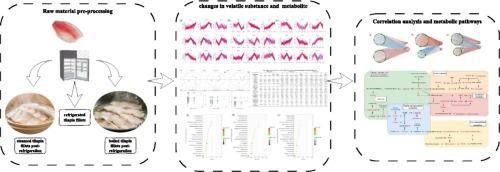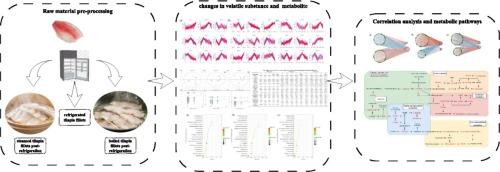基于代谢组学的罗非鱼鱼片冷藏蒸煮前后挥发性物质变化研究
IF 9.8
1区 农林科学
Q1 CHEMISTRY, APPLIED
引用次数: 0
摘要
本研究利用SPME-GC-MS和LC-MS分别对罗非鱼鱼片在冷藏过程中蒸煮前后的主要挥发性物质和代谢产物进行了研究。结果表明,冷藏后未经处理、蒸熟和煮熟的罗非鱼鱼片分别含有15、22和23种主要挥发性物质,主要是醛类、醇类和酮类。PLS-DA分别鉴定出97、70和67种差异代谢物。主要的差异代谢物被分类为脂质和类脂质分子(34,28,29),有机酸和衍生物(18,7,10),以及核苷,核苷酸和类似物(8,8,10)。冷藏后未处理、蒸熟和水煮罗非鱼鱼片中,13、15和10种关键挥发性物质分别与脂质和类脂分子呈正相关。氨基酸、脂质和核苷酸代谢被确定为关键挥发性物质生产的潜在代谢网络。这些研究结果为优化高风味高品质冷藏鱼制品的加工和烹饪应用提供了理论基础。本文章由计算机程序翻译,如有差异,请以英文原文为准。


Insights into volatile substance changes of tilapia fillets before and after steaming and boiling during refrigeration based on metabolomics
This study investigated the key volatile substances using SPME-GC–MS and metabolites using LC-MS, as tilapia fillets before and after steaming and boiling during refrigeration. Results indicated untreated, steamed, and boiled tilapia fillets post-refrigeration exhibited 15, 22, and 23 key volatile substances, respectively, primarily aldehydes, alcohols, and ketones. 97, 70, and 67 differential metabolites were identified by PLS-DA, respectively. The predominant differential metabolites were categorized as lipid and lipid-like molecules (34, 28, 29), organic acids and derivatives (18, 7, 10), and nucleosides, nucleotides, and analogs (8, 8, 10). In untreated, steamed and boiled tilapia fillets post-refrigeration, 13, 15 and 10 key volatile substances respectively showed positive correlations with lipids and lipid-like molecules. Amino acid, lipid, and nucleotide metabolism were identified as potential metabolic networks for key volatile substances production. These findings provide a theoretical foundation for optimizing high flavor quality processing and culinary applications of refrigerated fish products.
求助全文
通过发布文献求助,成功后即可免费获取论文全文。
去求助
来源期刊

Food Chemistry
工程技术-食品科技
CiteScore
16.30
自引率
10.20%
发文量
3130
审稿时长
122 days
期刊介绍:
Food Chemistry publishes original research papers dealing with the advancement of the chemistry and biochemistry of foods or the analytical methods/ approach used. All papers should focus on the novelty of the research carried out.
 求助内容:
求助内容: 应助结果提醒方式:
应助结果提醒方式:


